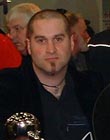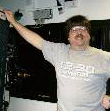|
|
This topic comprises 2 pages: 1 2
|
|
Author
|
Topic: Auto strike on motor start.
|
Stephen Furley
Film God

Posts: 3059
From: Coulsdon, Croydon, England
Registered: May 2002
|
 posted 08-09-2002 06:19 AM
posted 08-09-2002 06:19 AM




I have seen a few places, including one where I was running the show, where the xenons auto strike on the motor start, and go out on the motor stop. What is the point in this?In some cases a lamp can take a few seconds to settle down, and is not at its best whin the picture hits the screen. I think there is usually a manual strike button which gets round this problem, but even worse is the problem of not being able to stop the motor, without putting the lamp out. This may not be such a problem with platters, but is a real pain if running changeovers with short reels, sometimes several films of just a few minutes each, or if running a sngle machine with adverts and trailers on a spool on the porjector, then main feature on a tower, something quite common at independents here in the uk. (you can run the adverts and trailers while the tower is rewinding the feature). Even if you are running on a platter, it means puting the lamp out for just a few minutes, while you rethread, and then re-striking. The only possible advantage I can see to this is that it might slightly simplify an automation system, I don't know anything about them and have never run one, but I suppose that the lamp strike would be one less event to have to programme into the system, but this hardly seems like a major advantage. What is the reason for this, especially in a changeover house? (single screen, built just a few years ago with brand new FP30Ds and Kinoton lamphouses).
| IP: Logged
|
|
|
|
Steve Guttag
We forgot the crackers Gromit!!!

Posts: 12814
From: Annapolis, MD
Registered: Dec 1999
|
 posted 08-09-2002 07:57 AM
posted 08-09-2002 07:57 AM




It is "the Kinoton way" to have the lamphouse powered via the projector and to have the lamphouse follow the motor when going in the forward direction.You may, or may not have a lamphouse douser too...to Kinoton, they are extras...after all if the lamp is turning off with the motor, who needs em? Another "feature" of the Kinoton system is that the lamphouse fans turn off when the lamp turns off, unless the thermal switch wants to keep em running until it cools sufficiently. That being said, there is NOTHING to keep you or your technician from changing the hook up method to your suiting. All of our systems have the lamp turn on the "American" way. If you or the automation want it on, it comes on. If you or the automation want it off, it goes off. All of the ones we sell also have dousers in them too. Steve ------------------
"Old projectionists never die, they just changeover!"
| IP: Logged
|
|
Pete Naples
Phenomenal Film Handler

Posts: 1565
From: Dunfermline, Scotland
Registered: Feb 2001
|
 posted 08-09-2002 08:50 AM
posted 08-09-2002 08:50 AM




Yes, I never connect Kinoton as Kinoton intended. I stick to the simple, or American way, ie The rectifier powers the lamphouse, you turn on the rectifier and the lamp strikes. I do however, wire in either a timer relay or a switch to allow the fans to run after the buld is shut down. Curiously enough the Erneman does this itself, the fans run for some time after shut down, and the it doesn't put the lamp out when the motor stops, it waits a couple of minutes, allowing for reel change, lens change or whatever. Never seen a Kinoton lamphouse without a dowser tho'!
| IP: Logged
|
|
|
|
|
|
Paul G. Thompson
The Weenie Man

Posts: 4718
From: Mount Vernon WA USA
Registered: Nov 2000
|
 posted 08-09-2002 12:33 PM
posted 08-09-2002 12:33 PM




Proper grounding and RF suppression should remove the ignition noise from the sound system. Even if the CO douser is closed, the shutter can still catch hell if it is not rotating. Some projectors have very flimsy shutters, and a huge xenon lamp could frizzle the flimsey shutters in a matter of seconds. The majority of theatres I have seen have the igniter circuit energized upon motor start. I don't like the idea of the bulb striking proir to motor start, unless the hand douser is closed. In remote-start houses, early lamp ignition proir to motor start could be a problem. Nobody is there to close the hand douser. Pete, I never saw a system that had an automatic hand douser, but that could be an answer to frying shutters.
| IP: Logged
|
|
|
|
|
|
|
|
|
|
|
|
|
|
|
|
Steve Guttag
We forgot the crackers Gromit!!!

Posts: 12814
From: Annapolis, MD
Registered: Dec 1999
|
 posted 08-09-2002 09:51 PM
posted 08-09-2002 09:51 PM




The Strong CNA series automations also have the option for xenon sensors...they work too!I have installed electric douser systems. Basically have the douser only open when the motor is running (pretty much what one would do anyway). When running automated or remote control shows, the electric douser has it's advantages. For the manual show, a manual douser is best. Steve ------------------
"Old projectionists never die, they just changeover!"
| IP: Logged
|
|
|
|
All times are Central (GMT -6:00)
|
This topic comprises 2 pages: 1 2
|
Powered by Infopop Corporation
UBB.classicTM
6.3.1.2
The Film-Tech Forums are designed for various members related to the cinema industry to express their opinions, viewpoints and testimonials on various products, services and events based upon speculation, personal knowledge and factual information through use, therefore all views represented here allow no liability upon the publishers of this web site and the owners of said views assume no liability for any ill will resulting from these postings. The posts made here are for educational as well as entertainment purposes and as such anyone viewing this portion of the website must accept these views as statements of the author of that opinion
and agrees to release the authors from any and all liability.
|

 Home
Home
 Products
Products
 Store
Store
 Forum
Forum
 Warehouse
Warehouse
 Contact Us
Contact Us




 Printer-friendly view of this topic
Printer-friendly view of this topic



















